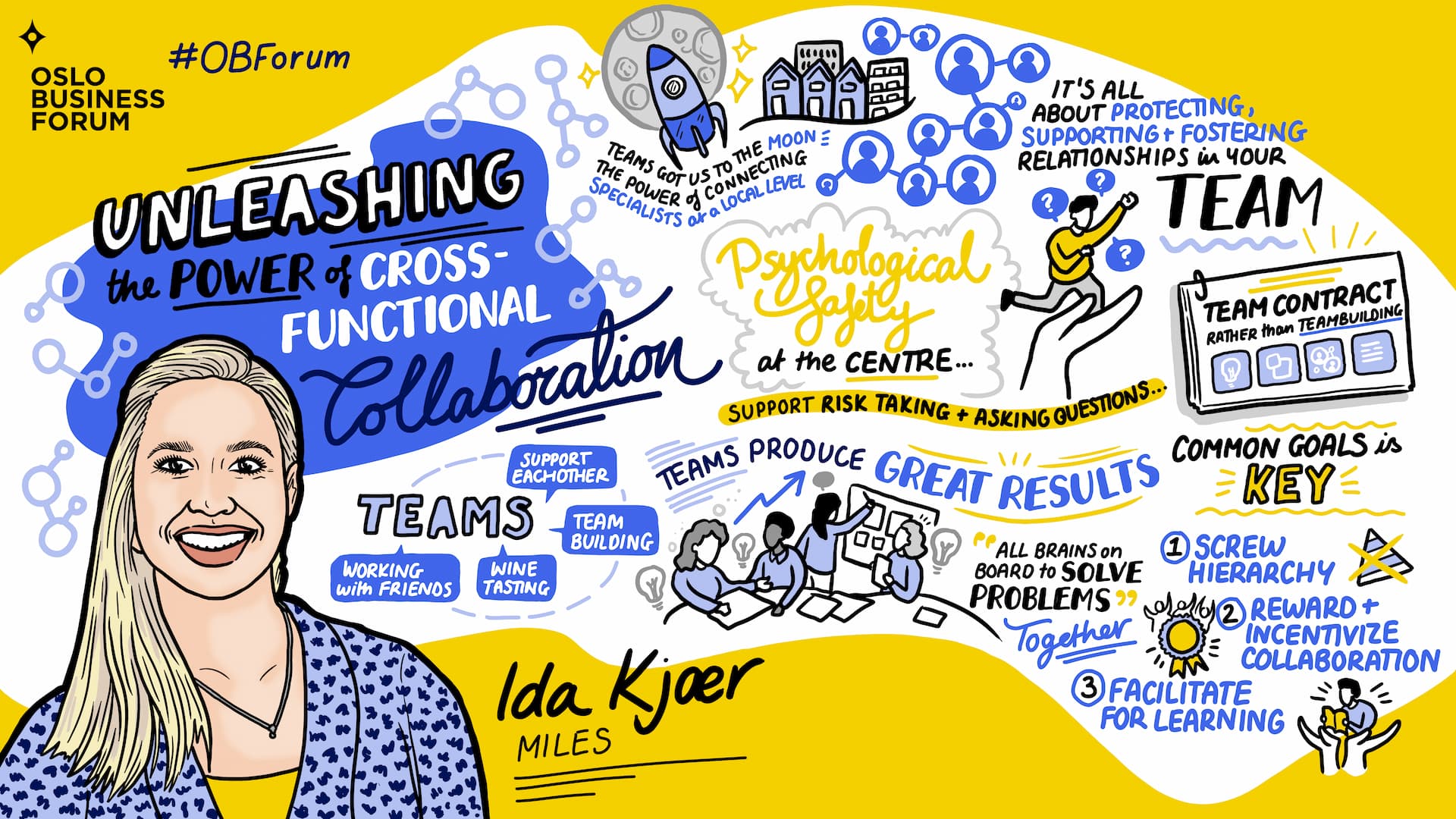In a moderated discussion at Oslo Business Forum, Ida revealed to leaders how to elevate the performance of their businesses by unleashing the power of cross-functional collaboration and teamwork.
Ida Kjær is a self-described agile nerd and enthusiast and an Agile Lead at Miles, a unique IT company that offers project delivery, consulting services, and agile coaching. She is also the co-founder and host of the podcast Smidigpodden about agile culture and leadership.
What comes to mind when you hear the word ‘team’?
When we think of working on a team, our feelings may range from energized to frustrated. You might remember fun work with friends or colleagues—or you might recall the time you were left alone in the office to finish a project while your coworkers went home.
“We all have different experiences with teams, some good and some evidently bad,” said Ida. “So why do we do it?”
We do it because teams produce great results. Ida noted that research shows great organizations benefit from teamwork. Working with teams:
- Yields fewer mistakes.
- Increases competitive advantage.
- Creates higher emotional well-being.
- Reduces the risk of burnout.
- Increases opportunities for growth.
- Expands creativity and innovation.
.jpg?width=680&height=453&name=DSCF5473%20(1).jpg)
Ida Kjær, Agile Lead at Miles AS and Co-host at Smidigpodden (agile podcast)
Teamwork is Demanding
In a world with increased complexity and uncertainty, we need teams and their collective capabilities to solve problems. But there’s no mistaking it: being on a team is hard.
When you join or manage a team, you may need to work in less comfortable ways, or you might run into conflict more often. Ida pointed out that relational management is critical when it comes to teamwork. “If you double your team size from 9 to 17 people, you quadruple the number of relations you have to manage,” she said.
But despite the challenges, there are risks associated with not engaging in teamwork. Without teams, we lose our cutting-edge expertise and our competitive advantage.
“If it’s so hard, should we just give in?” Ida asked.
She shared an example of a cross-functional team to demonstrate why it’s worth the work. A group of children had been bouncing around the health system for years, and the professionals working with them had nearly given up. They decided to try one last thing to save them. They tore down traditional hierarchies and created a cross-functional team with medical specialists from different fields. These specialists collaborated across fields, disregarding their roles, uncovered the root cause of the problems, and saved the children’s lives.
How to Make It Work
A team can be a group of developers, a leadership team, or the board of directors. No matter the size or makeup of a team, Ida believes the most successful share several key traits.
They have common goals. “If you don’t have a collective goal and you have individual goals, you get distracted by those,” Ida said. “At Miles, we have three goals, and they are crystal clear.”
They set aside hierarchy. “You need to incentivize working together as a team,” said Ida. “If we incentivize individual behavior, we get individual behavior. We will get self-centered decisions.”
They dedicate time to learning and creativity. “If you have cross-functional teams, you need to set aside time for people to focus on their expertise area with others who also have that expertise,” Ida said.
They foster psychological safety. “Psychological safety is an individual experience,” said Ida. “Different people can have a different degree of perceived psychological safety within the same team.”
They set aside time for reflection. “Do it often, do it regularly, and do it right,” Ida said. “It is one of the easiest and most powerful tools for continuous improvement.”
The most successful teams bring all these elements together in a team contract. “Research has found that a team contract is much more powerful than teambuilding when it comes to building resilient teams,” Ida said.
When Ida consults with teams, a contract is one of the first things they work on together. “Think of it as a foundation,” she said. A team contract will allow you to establish expectations, identify the team’s purpose, create roles, and set norms.
A Call to Action
Ida left leaders at Oslo Business Forum with three actions they can take immediately.
1. Create a team contract. Focus on expectations, purpose, roles, and norms. “Remember that everyone should contribute,” Ida said. “Don’t dictate.”
2. Be interested in your people. “There is no such thing as work and life,” Ida said. “There is only life.”
3. Dedicate time for reflection. Set aside time to be retrospective. “It’s the only way you can learn and continuously improve,” said Ida.
Key Points
- The most successful cross-functional teams share several key traits:
- They have common goals.
- They set aside hierarchy.
- They dedicate time to learning and creativity.
- They foster psychological safety.
- They set aside time for reflection.
- A team contract helps build resilient teams. The contract should include expectations, purpose, roles, and norms.
Questions to Consider
- How do you view teamwork? Do you see it as an opportunity to boost engagement and performance or a necessary evil?
- Is your team working towards a common goal? What can you do to clarify your purpose?
- Is hierarchy getting in the way of teamwork in your organization? Can you disregard role structures to collaborate more effectively?
- Imagine bringing your people together to build your team contract. What expectations and norms will you include?
Want to be a part of the OBF community? Join Oslo Business Forum 2024: Courageous Leadership now!
